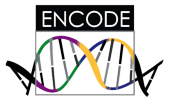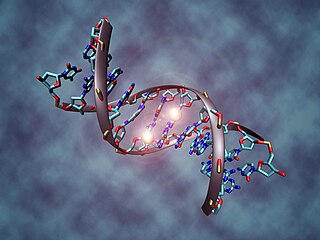Related Research Articles

An epigenome consists of a record of the chemical changes to the DNA and histone proteins of an organism; these changes can be passed down to an organism's offspring via transgenerational epigenetic inheritance. Changes to the epigenome can result in changes to the structure of chromatin and changes to the function of the genome.

The Encyclopedia of DNA Elements (ENCODE) is a public research project which aims to identify functional elements in the human genome.

Computational epigenetics uses bioinformatic methods to complement experimental research in epigenetics. Due to the recent explosion of epigenome datasets, computational methods play an increasing role in all areas of epigenetic research.
Epigenomics is the study of the complete set of epigenetic modifications on the genetic material of a cell, known as the epigenome. The field is analogous to genomics and proteomics, which are the study of the genome and proteome of a cell. Epigenetic modifications are reversible modifications on a cell's DNA or histones that affect gene expression without altering the DNA sequence. Epigenomic maintenance is a continuous process and plays an important role in stability of eukaryotic genomes by taking part in crucial biological mechanisms like DNA repair. Plant flavones are said to be inhibiting epigenomic marks that cause cancers. Two of the most characterized epigenetic modifications are DNA methylation and histone modification. Epigenetic modifications play an important role in gene expression and regulation, and are involved in numerous cellular processes such as in differentiation/development and tumorigenesis. The study of epigenetics on a global level has been made possible only recently through the adaptation of genomic high-throughput assays.
Human Epigenome Project (HEP) is a multinational science project, with the stated aim to "identify, catalog, and interpret genome-wide DNA methylation patterns of all human genes in all major tissues". It is financed by government funds as well as private investment, via a consortium of genetic research organisations.
Cancer genome sequencing is the whole genome sequencing of a single, homogeneous or heterogeneous group of cancer cells. It is a biochemical laboratory method for the characterization and identification of the DNA or RNA sequences of cancer cell(s).
The Epigenomics database at the National Center for Biotechnology Information was a database for whole-genome epigenetics data sets. It was retired on 1 June 2016.
The International Human Epigenome Consortium (IHEC) is a scientific organization, founded in 2010, that helps to coordinate global efforts in the field of Epigenomics. The initial goal was to generate at least 1,000 reference (baseline) human epigenomes from different types of normal and disease-related human cell types.

Epigenome editing or Epigenome engineering is a type of genetic engineering in which the epigenome is modified at specific sites using engineered molecules targeted to those sites. Whereas gene editing involves changing the actual DNA sequence itself, epigenetic editing involves modifying and presenting DNA sequences to proteins and other DNA binding factors that influence DNA function. By "editing” epigenomic features in this manner, researchers can determine the exact biological role of an epigenetic modification at the site in question.
ATAC-seq is a technique used in molecular biology to assess genome-wide chromatin accessibility. In 2013, the technique was first described as an alternative advanced method for MNase-seq, FAIRE-Seq and DNase-Seq. ATAC-seq is a faster and more sensitive analysis of the epigenome than DNase-seq or MNase-seq.
Hiroyuki Sasaki is a Japanese geneticist known for contributing to clarify epigenetic regulations during gametogenesis and embryogenesis through investigation of genomic imprinting as a model. He participates in the International Human Epigenome Consortium [IHEC].
H3K27me3 is an epigenetic modification to the DNA packaging protein Histone H3. It is a mark that indicates the tri-methylation at the 27th lysine residue of the histone H3 protein.
H3K9me3 is an epigenetic modification to the DNA packaging protein Histone H3. It is a mark that indicates the tri-methylation at the 9th lysine residue of the histone H3 protein and is often associated with heterochromatin.

Manolis Kellis is a professor of Computer Science at the Massachusetts Institute of Technology (MIT) in the area of Computational Biology and a member of the Broad Institute of MIT and Harvard. He is the head of the Computational Biology Group at MIT and is a Principal Investigator in the Computer Science and Artificial Intelligence Lab (CSAIL) at MIT.
Professor Susan J. Clark of the FAA is an Australian biomedical researcher in epigenetics of development and cancer. She was elected a Fellow of the Australian Academy of Science in 2015, and is a National Health and Medical Research Council (NHMRC) Senior Principal Research Fellow and Research Director and Head of Genomics and Epigenetics Division at the Garvan Institute of Medical Research. Clark developed the first method for bisulphite sequencing for DNA methylation analysis and used it to establish that the methylation machinery of mammalian cells is capable of both maintenance and de novo methylation at CpNpG sites and showed is inheritable. Clark's research has advanced understanding of the role of DNA methylation, non-coding RNA and microRNA in embryogenesis, reprogramming, stem cell development and cancer and has led to the identification of epigenomic biomarkers in cancer. Clark is a founding member of the International Human Epigenome Consortium (IHEC) and President of the Australian Epigenetics Alliance (AEpiA).
Human epigenome is the complete set of structural modifications of chromatin and chemical modifications of histones and nucleotides. These modifications affect gene expression according to cellular type and development status. Various studies show that epigenome depends on exogenous factors.
H3K4me1 is an epigenetic modification to the DNA packaging protein Histone H3. It is a mark that indicates the mono-methylation at the 4th lysine residue of the histone H3 protein and often associated with gene enhancers
H3K79me2 is an epigenetic modification to the DNA packaging protein Histone H3. It is a mark that indicates the di-methylation at the 79th lysine residue of the histone H3 protein. H3K79me2 is detected in the transcribed regions of active genes.
H3K36me2 is an epigenetic modification to the DNA packaging protein Histone H3. It is a mark that indicates the di-methylation at the 36th lysine residue of the histone H3 protein.
H3K36me is an epigenetic modification to the DNA packaging protein Histone H3, specifically, the mono-methylation at the 36th lysine residue of the histone H3 protein.
References
- ↑ "Time for the epigenome". Nature. 463 (7281): 587. February 2010. Bibcode:2010Natur.463Q.587.. doi: 10.1038/463587a . PMID 20130607.
- ↑ Abbott, A. (February 2010). "Project set to map marks on genome". Nature. 463 (7281): 596–7. doi: 10.1038/463596b . PMID 20162836.